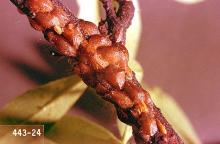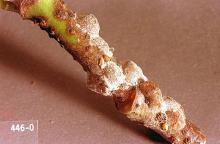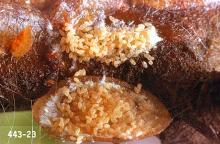Parthenolecanium corni
Pest description and crop damage This is a minor pest in commercial pear orchards. Adult scales are up to 0.2 inch across, reddish brown, and rounded. The adults resemble small helmets or bumps on branches, stems, and the underside of leaves. The crawlers are flat, oval, and pinkish brown. Scales are closely related to aphids, mealybugs, and whiteflies. Like these insects, they also have piercing-sucking mouthparts. Large populations of scale can devitalize plants and retard growth. Severe infestations can kill twigs. Large quantities of honeydew are produced, which causes russeting on fruit and growth of sooty mold fungus.
Biology and life history Lecanium scale overwinters in an immature state on twigs and branches. They resume feeding in the spring, and eggs are laid underneath the female (from May to June) where they remain until they hatch in early summer. The young scales, called "crawlers," migrate to the undersides of leaves to feed. Young scales also can be dispersed by wind, rain, irrigation, or by the movement of people and machinery. After four to six weeks on the leaves, the immatures return to the stems and twigs to feed, mate, and overwinter. There is one generation per year.
Pest monitoring Inspect twigs during the dormant season for scales. Pay particular attention to weak plants. The crawlers are best observed with a 10X magnifying glass, during May to July.
Management-biological control
Larvae of green lacewings and other insects, such as ladybeetles, are aggressive predators of lecanium scale.
Management-cultural control
Home orchardists: Scale can be rubbed off plants by hand with a glove or toothbrush. Major infestations can be pruned off. Tanglefoot, "stickem," or a similar adhesive can be applied around infestations of adult scales to catch the crawler stage. As with aphids, avoid excessive nitrogen fertilizer or water applications, as this favors population increase.
Management-chemical control: HOME USE
Time chemical controls for either the overwintering scales or the crawlers.
Dormant-season spray
Apply sprays during dormant or delayed-dormant period (March to April). Do not use after pink appears in buds. Use enough water to cover all of the tree thoroughly, including small limbs and shoots.
- superior-type oil-Some formulations OMRI-listed for organic use.
Growing-season spray
Insecticide applications are aimed at the vulnerable crawlers, during mid-summer. Apply insecticides about ten days after full petal fall (all petals off) or 17 to 21 days after full bloom. Avoid applying insecticides to blooming plants in order to avoid bee injury. Follow all label directions.
- carbaryl
Management-chemical control: COMMERCIAL USE
Chemical control for lecanium scale is generally not required in commercial pear orchards.




